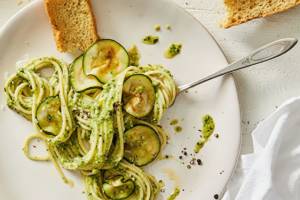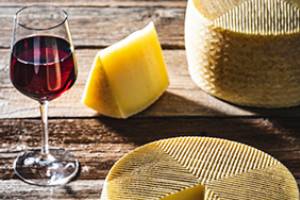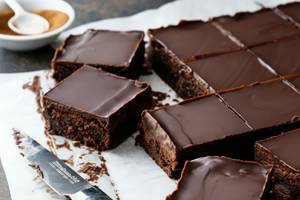
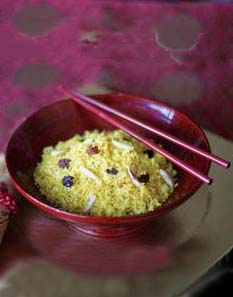
Kalijira rice from Bangladesh is considered to be the finest tiny aromatic rice in the world. It is shown here in a pilaf. Photograph courtesy Lotus Foods.
October 2007
Updated September 2023
|
 |
Rice: History & Types Of Rice
Page 4: Rice Glossary Terms I ~ K
This is Page 4 of a six-page article and glossary. Click on the black links below to visit other pages.
This material is copyrighted and cannot be reproduced in whole or in part
without written permission.
INDICA RICE or LONG-GRAIN RICE
There are two primary types of rice: the indica and japonica varieties. Indica rice varieties grow well near the equator. The kernel is four to five times longer than it is wide. When cooked, the rice is fluffy, with separate kernels. Basmati and jasmine are two well-known indica rices. See grain types and japonica rice.
|
|
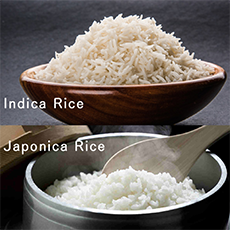
The two primary types of rice (photo © Global Insight Journal). |
INSTANT RICE or MINUTE RICE
Instant rice is white rice that has been parboiled (precooked) and dehydrated to enable a faster cooking time. It is cooked by adding one cup of boiling water to one cup of rice; then stirred, covered, and allowed to stand for one minute to reconstitute. It is more expensive due to the convenience, but less flavorful than regular rice.
|
|
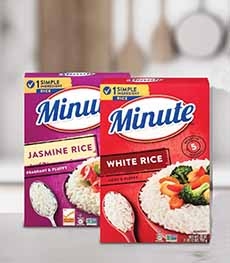
Instant rice is made in a number of varieties (photo © Minute Rice). |
JADE PEARL RICE or BAMBOO RICE
This organic, short-grain pearled white rice is infused with bamboo extract, the chlorophyll that tints the rice light green. When cooked it has a sticky yet fluffy texture and a delicate herbal taste and aroma. Use it in sushi, rice salad, risotto, and rice desserts. It is grown on family farms in northeast China using small-batch artisanal methods. When cooked, it is said to exude the aroma of a bamboo forest, with a light vanilla flavor.
|
|
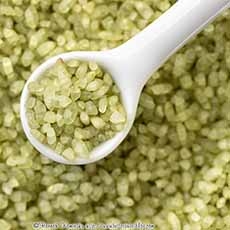
Jade pearl rice (photo © Hannah Kaminsky | Bittersweet Blog). |
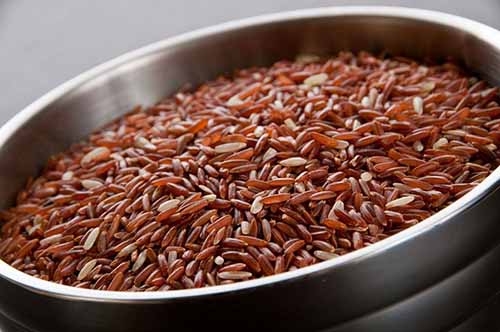
Red jasmine rice (photo © In Harvest | Riviana Foods).
JAPANESE RICE
This is not an official kind of rice. Consumers requesting “Japanese rice” are generally asking for short-grained rice for sushi. See also koshihikari rice.
JASMINE RICE
Grown in Thailand, jasmine is an aromatic long-grain rice that has a distinctive jasmine aroma after cooking and a faint flavor similar to that of popcorn. The cooked grains are soft, moist, and cling together. Jasmine is the most popular rice in Thailand and Southeast Asia. This excellent white rice cooks in a similar fashion to basmati but possesses a rounder, more starchy grain (i.e., it’s sticky, whereas basmati is not). It can be interchanged with white basmati rice in recipes. It naturally lends itself to coconut dishes and seafood dishes. Jasmine rice is a good source of B vitamins and complex carbohydrates. See the photo in the chart on the previous page.
|
|
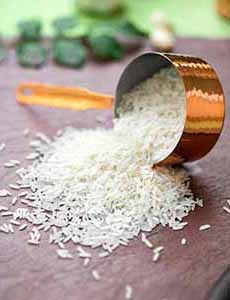
Jasmine rice (photo © Hannah Kaminsky | Bittersweet Blog). |
JAPONICA RICE or MEDIUM-GRAIN & SHORT-GRAIN RICE
Japonica rice is one of the two primary types of rice, the other being indica. It grows throughout the world in temperate and mountainous reasons. It is the moist, sticky, bright white rice used in sushi—medium-grain rice is moister and more glutinous (sticky) than long-grain rice, and it is ideal for Mediterranean and Asian dishes that require stickiness, like risotto, paella, and sushi. The kernel is two to three times longer than it is wide. There are different types of japonica rice including Calrose, developed at the Rice Experiment Station at U.C. Davis, which oversees the development of new and improved japonica varieties. The two japonica varieties favored by the Japanese are akita komachi and koshihikari, also grown in California.
|
|
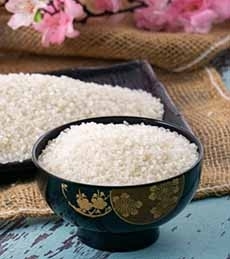
Japonica rice (photo © Far East Rice). |
KALJIRA RICE or KALO NUNIA or SMALL BASMATI
The “prince of rice” is considered the best tiny aromatic rice in the world. Grown in Bangladesh, this tiny, non-glutinous (not sticky) rice cooks in only 10 minutes (just like basmati rice) producing a delicate aroma, taste, and texture. It can be enjoyed as everyday plain rice or as an alternative to basmati, especially in a pilaf. It is traditionally seasoned with whole aromatic spices such as cinnamon sticks, cloves, and cardamom pods. Add some nuts, dried fruits, vegetables, and beans (or meats) to the rice and turn it into a main meal. Kalijira is also available in a brown rice variety through Lotus Foods and other purveyors. Also, see the photo at the top of the page.
|
|
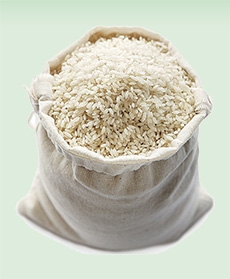
Japonica rice (photo © Far East Rice). |
While kalijeera rice closely mimics the nutty flavor and fragrant aroma of basmati rice, its shorter grains have a different visual appeal.
KOSHIHIKARI RICE
A short-grained japonica rice, considered by many to be the finest short-grain rice in Japan. It is also grown in California and elsewhere. It is used in biryani, paella, pilaf, risotto, sushi, and other foods. Koshihikari is rich in aroma and flavor, with a fine polish, and perfect sticky consistency. A bonus: It doesn’t get hard after cooling,
KUTHARI RICE
A red parboiled rice from Kerala, India. Also called rose matta rice.
|
|
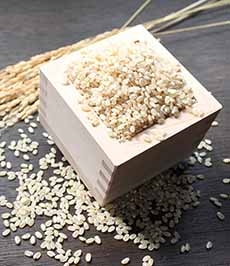
Japonica rice (photo © Far East Rice). |
Continue To Next Page: Terms L ~ R
Go To Article Index Above

|
